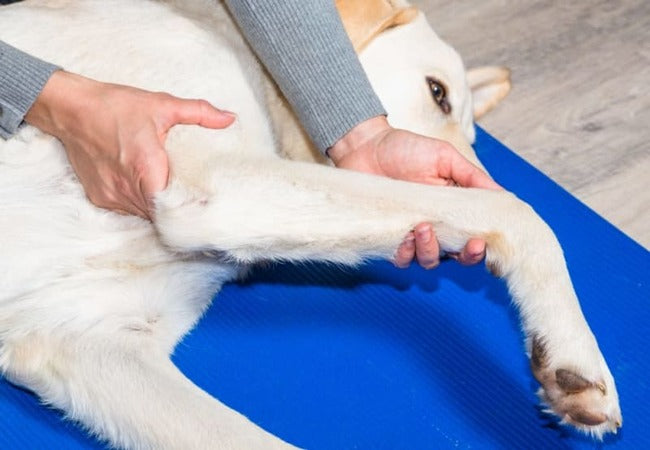Canine Knee Health 2025: 7 Vet-Approved Prevention & Treatment Tips 🐕🦵

In this article
🦴 7 Proven Ways to Prevent and Treat Canine Knee Injuries in 2025 🐾
By Dr Duncan Houston BVSc
Canine knee injuries, such as cranial cruciate ligament (CrCL) tears and patellar luxations, are common and can significantly impact your dog's quality of life. Understanding how to prevent and manage these injuries is crucial for maintaining your dog's mobility and happiness. Here are seven effective strategies:
1. 🧬 Understand Your Dog’s Risk Factors
Overview: Certain breeds are more prone to specific knee injuries. For example, large breeds like Labrador Retrievers and Rottweilers are susceptible to CrCL tears, while smaller breeds like Yorkshire Terriers and Chihuahuas often experience patellar luxations. Recognizing your dog's risk factors allows for proactive monitoring and early intervention.
2. 🏃♂️ Encourage Age-Appropriate Exercise
Overview: Regular, moderate exercise strengthens muscles and supports joint health. However, high-impact activities can strain your dog's knees, especially in senior dogs. Tailor exercise routines to your dog's age, breed, and health status to prevent overexertion.
3. ⚖️ Maintain a Healthy Weight
Overview: Excess weight increases stress on your dog's joints, elevating the risk of knee injuries. Implement a balanced diet and regular exercise regimen to keep your dog at an optimal weight, reducing the likelihood of joint strain.
4. 🧼 Provide Non-Slip Surfaces at Home
Overview: Slippery floors can lead to accidental slips and knee injuries. Use non-slip mats or rugs in areas where your dog frequently walks or plays to provide better traction and prevent falls.
5. 🩺 Seek Prompt Veterinary Attention for Lameness
Overview: Early signs of knee injuries include limping, stiffness, or reluctance to move. Prompt veterinary evaluation ensures accurate diagnosis and timely treatment, preventing further damage and promoting quicker recovery.
6. 🧘♀️ Consider Physical Therapy and Rehabilitation
Overview: Physical therapy, including hydrotherapy and controlled exercises, can aid in recovery from knee injuries and strengthen supporting muscles. Consult a veterinary rehabilitation specialist to develop a tailored therapy plan for your dog.
7. 🛠️ Explore Surgical Options When Necessary
Overview: In cases of severe knee injuries, surgical intervention may be required. Procedures like Tibial Plateau Leveling Osteotomy (TPLO) or Tibial Tuberosity Advancement (TTA) are common for CrCL tears, while patellar luxation surgeries realign the kneecap. Discuss surgical options with your veterinarian to determine the best course of action for your dog.
📱 Enhance Your Dog's Knee Health with Technology
Modern tools can assist in managing your dog's knee health effectively:
- Ask A Vet App: Access expert veterinary advice and schedule consultations conveniently.
- Woopf: Utilize training resources tailored to your dog's breed and behavior.
- Purrz: Monitor your dog's activity levels and set reminders for health check-ups and exercise routines.
🎯 Conclusion
Proactive care and early intervention are key to preventing and managing canine knee injuries. By understanding risk factors, maintaining a healthy lifestyle, and seeking timely veterinary care, you can ensure your dog remains active and comfortable.
For personalized guidance and support, visit AskAVet.com and download the Ask A Vet app today! 🐾📲






